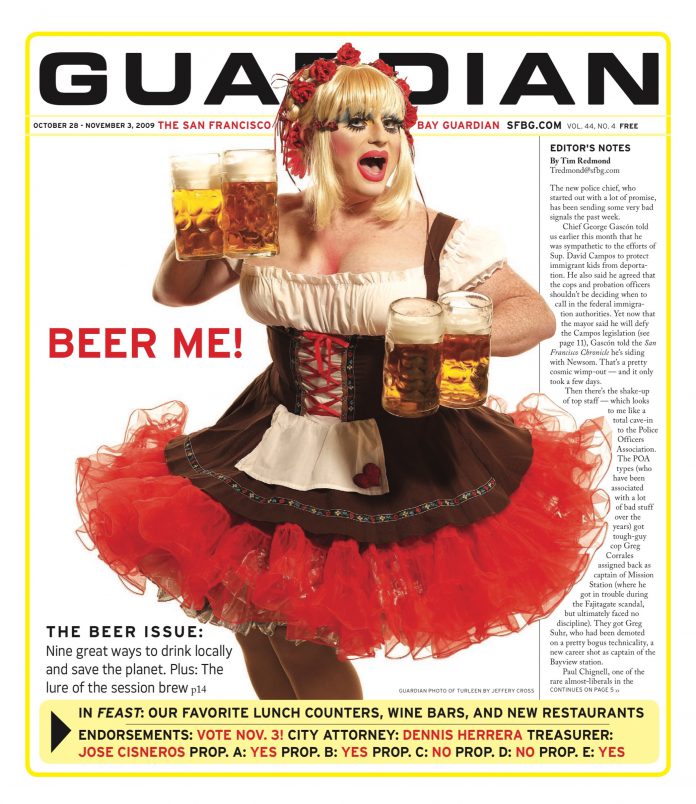johnny@sfbg.com
MUSIC Be aware — from new albums by Cold Cave to reissues on Minimal Wave, neo-gothic strains are in the air. Take one listen to the debut album by Demdike Stare. ‘Tis the season of the witch, but the spells cast by the 11 tracks on Symbiosis (Modern Love) will last well past Halloween to contend on Top 10 lists. Mancunian pair Miles Whitaker and Sean Canty tap into the oft-latent creep factor of dub and the vast darkness of techno, incorporating metal and film scores into those genres’ expansive space to create a distinctively present haunted sound. Neo-goths tend to have better aesthetics than their forebears, and this is the case here, as Whitaker and Canty pay homage to a classic 1922 cult film on witchcraft ("Haxan Dub"; "Haxan") and name their group after 17th-century reputed witch Elizabeth Southerns. Symbiosis is not without humor, though, particularly on "Entwistle Hall" (where moaning gives way to a climactic shriek) and "Trapped Dervish," which sounds exactly like its title.
Canty of Demdike Stare’s day job is at Andy Votel’s Finders Keepers label, the renowned crate-digging — grave-robbing? — label that recently unearthed Dracula’s Music Cabinet by the Vampires of Dartmore. A kitschy pre-krautrock oddity, that album adds quantity if not quality to the growing shelves of library music celebrated by the likes of Jonny Trunk, whose Trunk label has brought back the soundtracks of films such as Blood on Satan’s Claw (1971) and the original Wicker Man (1973). Connections between incidental and soundtrack music of the past and electronic musicians of the present are further — and better — underlined by Terror and Prey, the first releases by Muscovitch Music, a new label established by Joel Martin, who, along with Matt Edwards of Radioslave, is half of the neo-exotica act Quiet Village. The standout of the pair of film soundtracks by Ivor Slaney, Terror favors cold wave minimal electronic flourishes over generic rock. Made in 1978, the movie itself stars Tricia Walsh, who recently had a renewed splash of fame as the bug-eyed "YouTube lady" ranting about her soon-to-be-ex-husband’s many infidelities.
Terror‘s director Norman J. Warren aimed to create a no-budget British answer to Dario Argento’s 1976 Italo horror vision Suspiria. The influence of Argento and his pet group Goblin hangs heavy over contemporary horror-tinged electronic music, from the solemn rock-oriented efforts of Pittsburgh duo Zombi to, most recently, the comedic Horror Disco (Bear Funk) by Bottin. Bottin taps into the fact that Goblin’s Claudio Simonetti was a top creator of Italo disco, and also crafts an Italian answer to the cult games of France’s Black Devil Disco Club.
Neo-goth and horror music is an international phenomenon, ranging from the Knife in Sweden and Bottin in Italy to the U.S., where Philadelphia’s Cold Cave resides. Cremations (Hospital Productions) compiles parched, nihilistic alienation odes from Wesley Eisold’s early EPs, such as "Sex Ads," but it’s Love Comes Close (Matador) — with ex-Xiu Xiu member Caralee McElwoy brought into the fold — that connects as Cold Cave’s crossover move, the type of recording that will bring the trend to the mainstream. Yet in invoking Sisters of Mercy, Cabaret Voltaire, and Pornography-era Cure, Love Comes Close is not alone this year: the criminally ignored Chatterton (Systematic) by American-expat-in-Germany Chelonis R. Jones did so back in the spring, while updating Goblin’s Suspiria death drums on "Rehabilitation."
Still, England may be the current ground zero for neo-goth and retro and contempo sounds of horror, thanks in part to Demdike Stare, and to Trunk, Finders Keepers, and other labels. The latest spectral proof is Broadcast and Focus Group Investigate Witch Cults of the Radio Age (Warp). The Broadcast and Focus Group collaboration is a playful cousin of Symbiosis and a 21st-century musical answer to Bryan Forbes’ 1964 film Séance on a Wet Afternoon. Here, there, and everywhere, the ghosts aren’t just in the machine, they’re running it.

